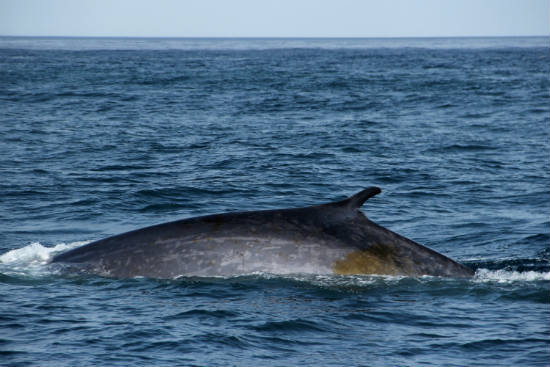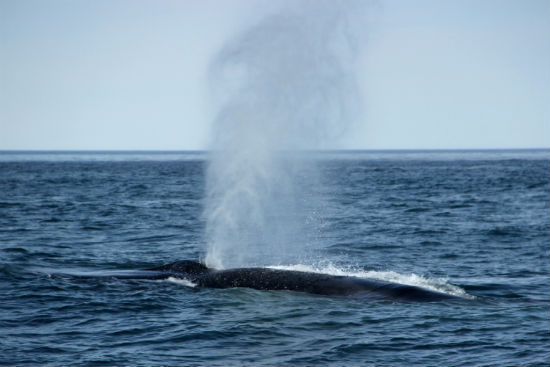Rorqual Hybrids
Family Balaenopteridae
Mammalian Hybrids
Balaena mysticetus [Bowhead Whale]
× Eubalaena japonica [North Pacific Right Whale] NHR. A whale photographed in the Bering Strait in 2009 was thought to be this hybrid. Kelly et al. 2010.
Balaenoptera acutorostrata [Common Minke Whale]
× Balaenoptera bonaerensis (♀) [Antarctic Minke Whale] NHR. These whales normally have disjunct ranges, but genetic analyses have confirmed that a female Antarctic minke whale that made an unusual migration to Arctic waters did in fact produce a hybrid with a common minke whale. This was the first documented case of such migration between the two hemispheres and of hybridization between these two whales. Glover 2010.
Balaenoptera bonaerensis [Antarctic Minke Whale] See: Balaenoptera acutorostrata.
 Above: Photo of a hybrid between blue whale and fin whale taken at Skjálfandi Bay, Iceland. When photographed in 2016, this individual had been returning to the bay annually since at least 2012. Its parentage was genetically verified from a skin sample by HAFRO, Iceland's marine research center in Reykjavik (Sarah Arndt, personal communication). Image: Sarah Arndt. More information
Above: Photo of a hybrid between blue whale and fin whale taken at Skjálfandi Bay, Iceland. When photographed in 2016, this individual had been returning to the bay annually since at least 2012. Its parentage was genetically verified from a skin sample by HAFRO, Iceland's marine research center in Reykjavik (Sarah Arndt, personal communication). Image: Sarah Arndt. More information A second photo to show the huge spout of the Skjálfandi Bay hybrid (same animal as above). Image: Sarah Arndt.
A second photo to show the huge spout of the Skjálfandi Bay hybrid (same animal as above). Image: Sarah Arndt.Balaenoptera musculus [Blue Whale]
× Balaenoptera physalus (↔, usually ♀) [Fin Whale] ONHR. These whales occur in mixed schools. CON: All oceans (hybrids have been reported from both the northern Atlantic and northern Pacific). HPF(♀♀). In the latter half of the twentieth century only five hybrids, three female and two male, were reported. Three were caught off Iceland during the 1980s and their hybridity was confirmed by molecular analysis. One was pregnant (after backcrossing with a blue whale). Spilliaert et al. (p. 188) thought the presence of a corpus albicans in this individual indicated a prior pregnancy. Another hybrid was killed off the coast of Spain in 1984. Doroshenko reported a hybrid captured in 1965 off Kodiak Island (Gulf of Alaska). In addition, a blue whale/fin whale hybrid has been observed returning annually to Skjálfandi Bay, Iceland (see photos above taken in 2016). Its dorsal fin and dark skin color are similar a fin whale, but its size and markings are like those of a blue (more information). More recently, Pampoulie (2021) genetically verified that fin whales are usually the mothers in this cross.
Such hybrids have long been known and were far more common formerly, when blue and fin whales were themselves more abundant. In Norwegian waters alone, Cocks (1887, pp. 217-218) lists ten such hybrids captured in the single year of 1886, and says (p. 216) that they were well-known to the whalers:
He goes on to give the lengths of many captured whales, both pure fin whales and fin whale/blue whale hybrids. One such hybrid, he says, reached
However, Cocks had earlier (pp. 213-214) listed the sizes of numerous captured blue whales, and some of these attained to even greater lengths. So fin-blue hybrids appear to be intermediate in size between their parents, as is the case in most, but not all, hybrid crosses. Two of the female hybrids listed by Cocks (see pp. 217 and 218) were pregnant.
References: Árnason 1995; Árnason and Gullberg 1993; Árnason et al. 1991; Bérubé and Aguilar 1998†; Doroshenko 1970; Hassanin et al. 2012; Spilliaert et al. 1991.
A whale killed off Iceland in July 2018 was a fin-blue hybrid (pictures).
× Megaptera novaeangliae (♂) [Humpback Whale] NHR. CON: Oceans worldwide. Folkens et al. (2002, pp. 236-237) say that "unlikely as it would seem given the considerable differences in size and morphology between the two species, there is one well-documented report of a Humpback-Blue Whale hybrid from the South Pacific." Blue whales (~30 m) are nearly twice as long as humpbacks (~17 m), and far heavier (maximum weight 180,000 kg vs. ~40,000 kg). Internet reports say the mother was a blue whale.
Balaenoptera physalus [Fin Whale] See: Balaenoptera musculus.
Eschrichtius robustus [Grey Whale]
× Megaptera novaeangliae [Humpback Whale] NHR. Waddell et al. (2000, p. 317) mention a hybrid, but give no details. CON: Pacific.
Eubalaena japonica [North Pacific Right Whale] See: Balaena mysticetus.
Megaptera novaeangliae [Humpback Whale] See: Balaenoptera musculus; Eschrichtius robustus.
By the same author: Handbook of Avian Hybrids of the World, Oxford University Press (2006).